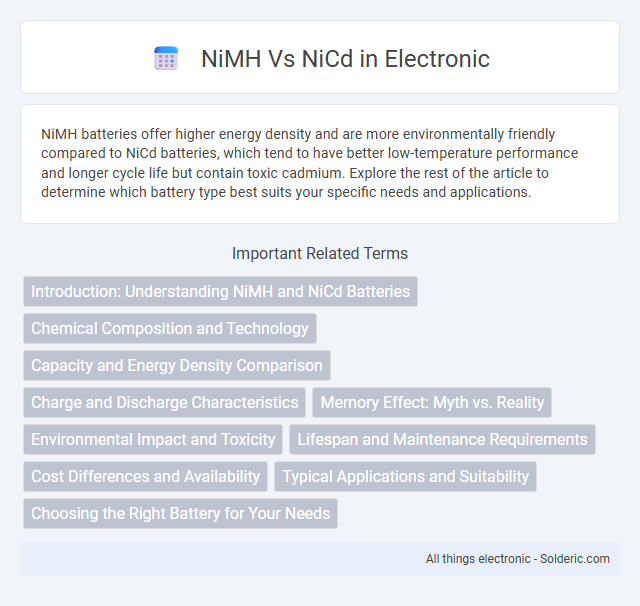NiMH batteries offer higher energy density and are more environmentally friendly compared to NiCd batteries, which tend to have better low-temperature performance and longer cycle life but contain toxic cadmium. Explore the rest of the article to determine which battery type best suits your specific needs and applications.
Comparison Table
| Feature | NiMH (Nickel-Metal Hydride) | NiCd (Nickel-Cadmium) |
|---|---|---|
| Capacity | Higher energy density (600-1200 mAh) | Lower energy density (500-1000 mAh) |
| Memory Effect | Less prone | Significant memory effect |
| Self-Discharge Rate | Moderate (20-30% per month) | Higher (10-15% per month) |
| Environmental Impact | Contains no toxic metals | Contains toxic cadmium |
| Cycle Life | 300-500 charge cycles | Up to 1000 charge cycles |
| Cost | Higher price | Lower price |
| Applications | Consumer electronics, hybrid vehicles | Power tools, emergency lighting |
Introduction: Understanding NiMH and NiCd Batteries
NiMH (Nickel-Metal Hydride) and NiCd (Nickel-Cadmium) batteries are rechargeable energy storage solutions widely used in electronic devices and power tools. NiMH batteries typically offer higher capacity, eco-friendliness, and lower memory effect compared to NiCd batteries, which are known for their robustness and performance under extreme conditions. Understanding the differences in chemical composition, recharge cycles, and environmental impact is essential for selecting the right battery type for specific applications.
Chemical Composition and Technology
NiMH batteries utilize a hydrogen-absorbing alloy as the negative electrode, offering higher energy density and less environmental impact compared to NiCd batteries, which rely on nickel oxide hydroxide and cadmium electrodes. The absence of toxic cadmium in NiMH technology reduces disposal concerns and aligns with stricter environmental regulations. Choosing NiMH can enhance your device's performance due to improved chemical composition and advanced battery technology.
Capacity and Energy Density Comparison
NiMH (Nickel-Metal Hydride) batteries typically offer higher capacity and energy density compared to NiCd (Nickel-Cadmium) batteries, making them more suitable for devices requiring longer runtime. NiMH cells generally provide 60-120 mAh/g of energy density, whereas NiCd cells offer around 45-80 mAh/g, resulting in lighter and more compact power sources. Choosing NiMH can enhance Your device's performance with better energy storage efficiency.
Charge and Discharge Characteristics
NiMH batteries exhibit higher capacity and energy density compared to NiCd, enabling longer discharge times at consistent voltage levels. NiCd batteries provide robust charge retention and perform well under high discharge rates but suffer from memory effect that can reduce effective capacity if not fully discharged before recharging. NiMH cells typically require more precise charging control to prevent overcharging and overheating, while NiCd tolerates faster charging cycles and harsher conditions without significant capacity degradation.
Memory Effect: Myth vs. Reality
NiMH batteries have a significantly reduced memory effect compared to NiCd cells, which historically experienced capacity loss due to incomplete discharge cycles. Modern NiMH technology minimizes voltage depression, allowing you to recharge without fully draining, enhancing usability. While NiCd batteries may still exhibit this phenomenon, their environmental impact and lower energy density make NiMH a preferred choice for most applications.
Environmental Impact and Toxicity
NiMH batteries have a lower environmental impact compared to NiCd batteries due to their reduced use of toxic heavy metals like cadmium, which poses significant risks to soil and water contamination. Recycling programs for NiMH batteries are more widely available and less complex, minimizing hazardous waste and promoting sustainability. Your choice of NiMH over NiCd helps reduce ecological toxicity and supports safer battery disposal practices.
Lifespan and Maintenance Requirements
NiMH batteries generally offer a longer lifespan, with around 500 to 1000 charge cycles compared to NiCd's 300 to 500 cycles, making them more durable for frequent use. NiCd batteries require regular deep discharging to prevent memory effect, whereas NiMH batteries have reduced memory issues but still benefit from occasional full discharges to maintain capacity. Maintenance for NiMH is simpler and less demanding, resulting in lower long-term care needs compared to NiCd batteries.
Cost Differences and Availability
Nickel-Metal Hydride (NiMH) batteries generally have a higher upfront cost compared to Nickel-Cadmium (NiCd) batteries due to their improved energy density and environmental benefits. NiCd batteries are more widely available and often cheaper, making them a cost-effective choice for applications requiring high discharge rates or rugged performance. NiMH batteries are increasingly accessible in consumer markets, especially for rechargeable devices, while NiCd remains prevalent in industrial and specialized uses because of its lower price and established supply chain.
Typical Applications and Suitability
NiMH batteries are ideal for consumer electronics, cordless phones, and hybrid vehicles due to their higher capacity and environmental friendliness, making them suitable for devices with moderate to high energy demands. NiCd batteries excel in power tools, emergency lighting, and aviation equipment because of their robustness, high discharge rates, and ability to perform well in extreme temperatures. Your choice depends on whether you prioritize capacity and eco-friendliness (NiMH) or durability and performance under demanding conditions (NiCd).
Choosing the Right Battery for Your Needs
NiMH batteries offer higher energy density and longer runtime compared to NiCd, making them ideal for devices requiring extended power. NiCd batteries excel in durability and performance under extreme temperatures, suitable for heavy-duty applications. Your choice depends on balancing capacity needs, environmental impact, and device compatibility to ensure optimal battery performance.
NiMH vs NiCd Infographic

 solderic.com
solderic.com